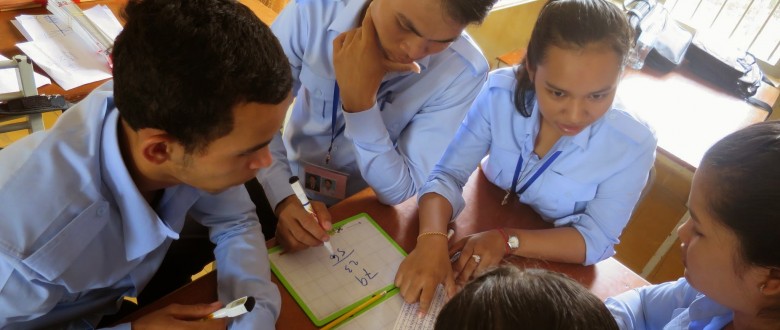
The European Week of Action for Girls (10 – 14 October) is all about GIRL POWER. An ideal opportunity to reflect on just a few examples of how VVOB secures the right of girls and young women to quality education, both in our partner countries and in Flanders.
To start off on a positive note: the gender gap in terms of enrolment in primary education in Cambodia is gradually closing. But no reason to cheer for victory yet. The chances of a female student still dropping out of school grows with age. Indeed, in upper secondary schools and tertiary education systems the girl student is underrepresented. Girls and young women need strong female role models, both physically in front of them and in learning materials, to feel empowered to be something other than, or in addition to, a mother or caregiver and stay in school to achieve their own goals.
VVOB developed new teaching materials for maths and sciences for all teacher training centres for primary education in Cambodia. These materials were subjected to a comprehensive gender-check, making sure that men and women, boys and girls were represented fairly. “I am proud to see my student teachers putting this into teaching practice. They make sure that girls and boys equally have leading roles during group exercises in their classrooms”, said Ms. Sek Soyoeun, a maths teacher trainer at the Prey Veng Provincial Teacher Training Centre.
Misrepresentation
There are many factors that lead to gender disparity in Cambodian schools. The lack of female role models to look up to for young learners, such as educated mothers and female teachers, is an important reason why some quit school during their adolescent years.
The teaching profession has indeed been male-oriented for a very long time in Cambodia, but there is a positive trend towards greater feminisation of the profession. However, teacher trainers are still mostly male (63 percent) and this male dominance grows stronger at every next level of the education system. An astounding 85 percent of school principals are men for example, and only 13 out of 45 (Deputy) Directors of the Provincial Teacher Training Centres are female.
There are two inevitable consequences for girl students. First, this disparity at higher level strengthens the stereotypes of boys being ‘leaders’ and girls being ‘followers’, curbing the enthusiasm in some otherwise ambitious girls to pursue their education further. Second, it raises questions about how well the male-dominated education system is addressing these limiting stereotypes. After all, you cannot fix what you do not fully understand or acknowledge.
Dismantling limiting stereotypes
VVOB is working with all 18 Provincial Teacher Trainer Centres to break this vicious cycle of misrepresentation of girls, especially in maths and sciences. We have introduced gender mainstreaming concepts in teacher training, so student teachers are encouraged to counter gender stereotypes in their teaching practice by promoting female scientists as role models, for example.
In cooperation with the teacher training centres, we also developed new, female-friendly science and maths teaching material, amongst which three gender-neutral textbooks for maths and two for science (see examples below). They were gender-checked with UNESCO’s Toolkit: Is the language gender-neutral? Are men and women represented equally? What psychological traits are attributed to female and male characters? The textbooks were designed to dismantle existing stereotypes in the materials young learners read and stimulate girls by depicting female role models in active roles. “This gender-check needs to become a systematic reflex in all our activities”, says Tom Vandenbosch, VVOB’s Gender Focal Person. VVOB also trained teacher trainers in gender-checking their own teaching materials and formulated gender-tips for teachers on how to equally engage girls and boys in maths and science classes.
Spill-over
“The textbooks were a big success with the teacher trainers”, says Karolina Rutkowska, Education Advisor for VVOB in Cambodia. “They even asked us to develop similar ones for biology and geography.” Maths teacher trainer Ms. Sek Soyoeun witnessed her students paying more attention to gender equity: “As a mentor during their teaching practice, I noticed that my student teachers applied in their classrooms what they had learned in mine. Groups for assignments are now mixed, and the student teachers give leading roles to girls and boys equally.” This sentiment is echoed by her science colleague Ms. Kem Sosethea from the Kampong Cham Provincial Teacher Training Centre: "In practice, for example, my students pay attention to gender equity by mixing up girls and boys in the classroom instead of separating them from each other."
The textbooks were officially endorsed by the Ministry of Education of Cambodia in 2015 and are now part of curriculum for student teachers. Gender-checking all our activities is a priority task for VVOB. For example, in Zambia we are working with the Forum for African Women Educationalists to gender-check the teacher trainer’s modules for early childhood education. In Belgium we have a similar partnership with RoSa.




